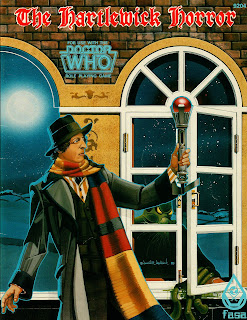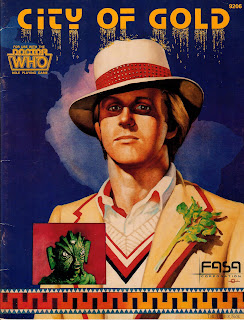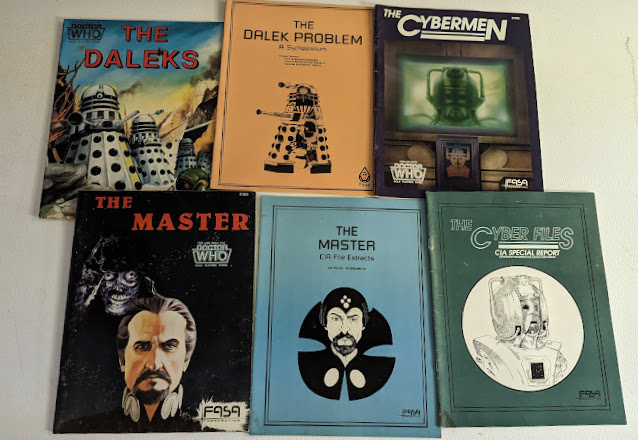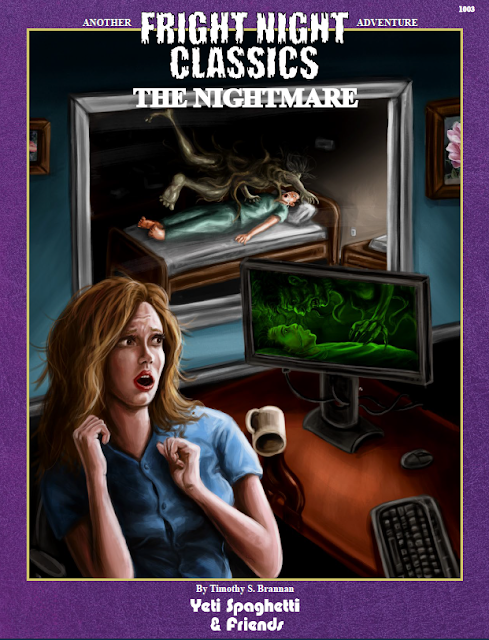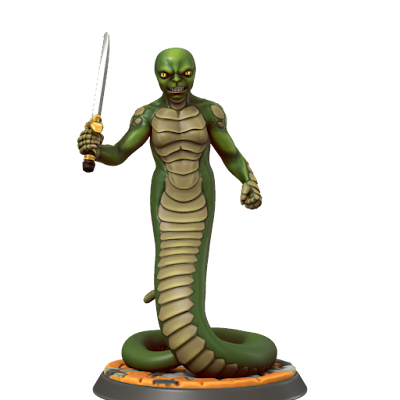
Titan City reaches beyond the sky and deep into the planet. Its soaring Empyreal Spires are home to the Plutogia, the ruling families, who know only a life of glittering beauty and untold wealth. At its heart is the Great Cannon, the greatest machine on the planet, capable of launching starships laden with rare and valuable minerals mined by the innumerable tunnels which bore into the planet’s crust. The limits of Titan City are marked by the walls of the impossibly large crater and beyond lies radioactive deserts, inhabited only by mutated beasts and half-life bandits capable of surviving the death-grey sands and poisoned atmosphere, all under a sky marked with three moons. Ten billion humans live in Titan City, many in the Undercity, amidst industrial ruins which stretch for miles and miles up and down as well as in any other direction. Here such humanity and other such outcasts—mutants and psions, survive as best they can. Enforcers ruthlessly break up any dissent or uprising from here in the Guts of the Titan City, but that is only an intermittent threat to inhabitants’ lives, their purses bled dry by the hyper-corporations and the air they breath wrapped in smog poisoned by the waste output from barely regulated factories. Under such grinding conditions, some of these Guts-dwellers make what purpose and hope they can. They join gangs, cults, rebellions, churches, anything to give them both purpose and hope. The gangs are everywhere, staking their claims to territories, making money from crime, dealing with rivals through ‘honourable’ agreements and bloody violence, trying to get bigger, better, and richer, grab all the power they can to be crime lords, not just petty gangs.
The is the setting for
Gangs of Titan City, a roleplaying game of crime and consequences in a far future underworld—literally and figuratively. Published by
SoulMuppet Publishing, it can be best described as BBC’s
Peaky Blinders meets Games Workshop’s
Necromunda in a
Judge Dredd-like Mega-City One, but vertical, in which the players take of the role of Gutters in a gang which wants to grow and be feared. As Gutters, the players will direct and roleplay the lives and development of their gang over three phases of play per session. In the ‘Escalation Phase’, the gang plans its next move. In the ‘Operation Phase’, the gang enacts its plan, and in the ‘Fallout Phase’, the gang suffers the consequences of their actions, for good or ill. Grabbing a Claim will often bring a gang into conflict with a potential rival and as the gang’s domain grows so will its rivalries and the consequences of its actions. How far will a gang go before the consequences threaten to overwhelm it, let alone individual gang members, will be revealed as a
Gangs of Titan City campaign progresses. And it is important to note that
Gangs of Titan City does require that progress to really work. The roleplaying game is better suited to campaign play than the one-shot because the consequences are not going to be fully explored in the short term, only the long term.
Gangs of Titan City is a storytelling roleplaying game in which the players are encouraged to be bold in their storytelling and their Gutters’ actions, as well as embrace and explore the consequences of those actions. It is player-driven in that there are no set plots and much of the setting can be created during play. However, it is a roleplaying game which deals with gangsters and that means that the players will be exploring the darker, criminal side of human nature. It is not surprise that
Gangs of Titan City carries warnings about its violent, traumatic themes that include body horror, injury, and death. Similarly, the inclusion of addiction and drug abuse should be no surprise either. Harm to animals is definitely a surprise, whilst as a Science Fiction roleplaying game which includes psionics, especially one of this nature, the invasion of privacy and mind control are also included as a possible issue. To be clear,
Gangs of Titan City does not dwell on these or condone, but instead indicates that they can be part of the game and its play given its dark nature. Thus, the use of Safety Tools is advised, but even so,
Gangs of Titan City deals with some surprisingly direct and mature themes.
The players in Gangs of Titan not only create their Player Characters or Gutters, but also their Gang. A Gang has an Archetype, three XP Prompts, which suggest activities and behaviours the gang can engage in to generate Experience Points; various details which will vary between Archetypes and add flavour rather than mechanical benefits; two Aspects or quirks, which again flavour rather than mechanical benefits; a Contact and a Rival; an Advancement, a powerful ability which gives the gang an advantage; and lastly, a Hideout connected to the Gang’s Claim and three Hazards. One hazard comes from the Gang’s Rival, one from its Hideout, and one from its Archetype. There are six Archetypes. A Consortium will make and sell anything because money equals power; a Cult worships something dark and terrible and wants more converts; an Enclave is made up of outcasts and the dispossessed trying to survive, make a space for their own, and even hit back at their oppressors; Mercenaries are guns for hire, the bigger the paycheck, the bigger the boom; Operatives work in secret, stealing, destroying, and keeping secrets; and Overlords just want to rule. Each entry gives lots of options to choose from, including names, so that there is lots of variation and the players can really make their gang their own.
Name: The Party Syndicate
Archetype: Consortium
XP Prompts: Negotiate a favourable price, force a competitor out of business, secure a supply or source
Starting Claim: Stack-Market
Core Product: Vice Peddling
Aspects: Wide-Ranging Suppliers, Catchy Slogan (“Our price, your vice”)
Consortium Gear: Emergency Funds (enough for a small bribe or two), Very Fancy Outfit for each Gutter
Consortium Hazards: City-Wide Shortage
Contact: Hekeret Tine, Corporate Stooge
Rival: Promolium Vol, Spire House Representative
Hideout: Bodega Bill’s Corner Shop
Consortium Advancements: Smugglers
Hazards: Bodega Bill’s Corner Shop gets a lot of footfall (Hideout), got Promolium Vol, Spire House Representative very drunk and got him to invest (Rival), already sold a whole load of filth (City-Wide Shortage)
A Gutter has a Class, three XP Prompts, six Approaches (or methods of dealing with a situation), Aspects (visual descriptors and quirks), Personality Traits (roleplaying prompts), a Contact and a Rival, Specialisms (skills and areas of knowledge), an Advancement, and some Gear. A Gutter always has one piece of Gear with him, plus one item related to a Specialism and one given to the Gutter by his Contact or taken from his Rival. The six Approaches range in value between -3 and +3 and are Overwhelm, Exploit, Dominate, Resolve, Calculate, and Appeal. There are eight different Classes. These are the Aberration, more or less Human; the Broker, ready to make any deal; the Bruiser, who provides muscle and close-up intimidation; Marksman, stealthy gun for hire; Mastermind, gifted liar and clever thinker; Psionicist, whose gift both marks them and gives them power; Spectre, the sneak and knife in the back; and Technomancer, combing man and machine. Like the Gangs, each of the Classes is nicely detailed with lots of elements for a player to choose from and individualise his Gutter, to which the player also assigns an array of values to the Gutter’s Approaches.
Name: Wolter Dabrurgun
Class: Spectre
XP Prompts: Deception, Stealth, Disabling Security
Approaches:
Overwhelm 0 Exploit +2 Dominate -1
Resolve +1 Calculate +1 Appeal 0
Aspects: Pale Skin, Goggles
Personality Traits: Careful, Manipulative
Contact: The Bird’s Foot, Alleged Master Thief
Rival: Horvas, Data-Mind Scavenger
Specialisms: Security measures, Cyber Splicing
Advancements: Are you sure about that?
Gear: Cybernetic Interface, Lockbreakers, Climbing Kit
Mechanically,
Gangs of Titan City is simple. If a Gutter wants to undertake an action, his player rolls two six-sided dice and applies the modifier from the appropriate Approach. A roll of ten or more indicates a Full Success, between seven and nine a Partial Success, and six or less, a Failure. Essentially, the equivalent of ‘Yes’, ‘Yes, but’, and ‘No’. Some abilities, including Specialisms, allow an additional die to be rolled, but only two are kept. Circumstances can add a single +1 bonus and rerolls of single dice are possible if the Gutter takes a point of Desperation.
Combat uses the same core mechanic. It tends to favour the Gutters initially; opponents tending only to act or have a Reaction when a Gutter’s player rolls a Partial Success or Failure on an attack. When this happens, the player makes a Resistance roll to avoid or withstand the effects of the attack. Essentially,
Gangs of Titan City is player-facing. Once a Gutter starts suffering damage, combat can get nasty. A Gutter only has three Damage Boxes, which are filled in with Scratches and Wounds, and if all three are filled in, it becomes a Critical Wound. Further damage can inflict Desperation, Trauma, or kill the Gutter. If a Gutter has too much Desperation at end of the three phases of
Gangs of Titan City’s play, there are multiple consequences that include burning a Contact, suffering a Trauma—which might be a Hatred, an Obsession, or a Weariness, and adding to the Gang’s Danger Table.
Gangs of Titan City’s rules also detail weapons, vehicles, and other gear in quite light detail. More detail is paid to Pharma-Serums, which are readily available across the city. These all have drawbacks, but provide an extra die for certain checks depending upon the Pharma-Serum. In terms of improvement, both Gang and Gutters can acquire further Advancements if they have sufficient Experience Points, which are gained from tagging their XP Prompts under dangerous circumstances. For the Gutter, a player can choose a new Advancement or Specialism from the Gutter’s Class, increase an Approach, or gain an Alteration. Alterations can be Cybernetic Augmentations, Gene-Mods, or Psionic Disciplines. Gaining Alterations can be easier for some Classes rather than others. For example, the Psion will only have access to Psionic Disciplines, but members of the other Classes can obtain the Cybernetic Augmentations and Gene-Mods—for a price and likely some roleplaying too. The players can spend their Gang’s Experience Points to take an Advancement for its Archetype or improve one of its Squads. In addition, a Gang’s Hideout can be improved with a new Feature or have an existing Feature upgraded.
Gangs of Titan City has a distinct Cycle of Play consisting of three phases. In the ‘Escalation Phase’, the gang plans its next move. In the ‘Operation Phase’, the gang enacts its plan, and in the ‘Fallout Phase’, the gang suffers the consequences of their actions, for good or ill. Each phase consists of several steps. For example, in the ‘Escalation Phase’ there are three steps. In the ‘Montage Phase’, the players explore what their Gutters are doing on a day-to-day basis, followed by a roll on ‘The Event Table’ which brings in a Rival or Faction into the story for that Cycle of Play, and then the Gang gets together to decide on its next ‘Gang Moves’. The ‘Operation Phase’ is when the Gutters go out and seize control of a Claim or Asset, launch a pre-emptive strike to remove a Hazard from the Gang’s Danger Table, or perform a job or contract for another Gang or faction, and this is when the Gutters will go out and actively, physically pursue the Gang’s aims. In the ‘Fallout Phase’, the Gutters and their players will resolve objectives, treat wounds, determine if the Gang’s actions has made sufficient ‘Noise’ to attract the authorities, check income, spend Experience Points, and more. All of this is intended to be played within a single session, although it need not be, and fundamentally player driven, with outside elements randomly generated by the Narrator. So, there are no set plots and the players need to be proactive more than reactive.
Gangs of Titan City is played on two levels. One is the tactical, often the individual level, when the Gutters are acting directly and the players are roleplaying them, often in the field. The other is strategic, when the Gutters plan their actions, direct their Squads, handle their Assets and Claims, and so on. Thus, there is a degree of resource management to the play, whether that is dealing with Assets and Claims, but also Debt. Debt represents how far a Gang’s resources are spread out or extended and works the same way as Desperation does for the individual Gutter. If a Gang has too much Debt at end of the three phases of
Gangs of Titan City’s play, there are multiple consequences that include burning an Asset, suffering a Hardship—which might be being Watched, Spread thin, or suffering from Loose Lips, and adding to the Gang’s Danger Table. Whilst Desperation and Debt track the consequences of the Gutters’ actions on the personal and collective levels, they both come together in the Danger Table. Entries can be added to the Danger Table because of both, but also due to Noise generated during the ‘Operation Phase’, taking Claims and assets from rival Gangs and Factions or doing jobs for them, and so on. As the Danger Table is filled with Leads, Jobs, and Hazards, these become storytelling elements which randomly come back into play and the Gutters have to deal with immediately. The entries on the Danger Table are never hidden, so there is always a problem or difficulty looming over the Gutters and their Gang, waiting to escalate into something that they must deal with immediately.
However,
Gangs of Titan City does require some set-up by the Narrator. Not necessarily a great deal, but it is not obvious from the outset. This includes creating a starting sector or two and then populating it with themes, factions, and a starting dynamic. Plus, an Asset web needs be drawn, connecting the players’ Gang and their Assets to the previous owners of those Assets, because every Asset has a previous owner! This of course, builds connections for the Gang, for both good and bad. As a campaign progresses, this Asset web will grow and grow. Fortunately, the Narrator’s role is strongly supported throughout with almost a third of the devoted to helping her run
Gangs of Titan City. The advice is good, including letting the players be cool, be open about the risks that their Gutters and Gang face, and almost in adversarial terms, that the Narrator can always get the Gutters and their Gang later if they are successful in their plans now! This does not mean that the Narrator is expected to be adversarial, but rather the successes of the Gutters and their Gang will come back to proverbially bite them through the Hazards and other entries on the Danger Table. There are also examples of almost everything that the Narrator can bring into play or use as inspiration, including Leads and Jobs. Various sector types are discussed as are the Enforcers who will act when the Gang causes too much Noise, and there are numerous example Gangs and Factions given too, ready to populate the sector.
Rounding out
Gangs of Titan City is an overview of the City of Plutogia, its major powers, and its technology. There is high degree of technology and gear being used over and over, and is not that far advanced from that of the twenty-first century. Advances (or not) include the Data-Brains, the brains of both animals and humans preserved and used as motherboards, wired into electronic devices, including computers, as well as A.I.s, laser and beam weaponry, and space travel, but it is unlikely that the Gutters will have access to that.
Physically,
Gangs of Titan City is in general well written and presented. The artwork is scrappy, but works well enough. The writing does suffer from being a little too succinct in places, but the main problem is the lack of index. This might not be an issue in another roleplaying game, but
Gangs of Titan City does have a lot of moving parts and interplay between the Gutters, their Gang, other Factions, and the consequences of the actions of both Gutters and Gang. What might have helped is a flowchart for the phases of the roleplaying game’s play that was readily accessible, perhaps placed inside the back cover of the book.
Gangs of Titan City is not a roleplaying game that everyone is going to want to play given its subject matter, dealing with crime and having the Player Characters—the Gutters—commit criminal and direct criminal acts. However, whilst
Gangs of Titan City does do that, it never lets them avoid the consequences of committing or directing such actions, and the roleplaying game is about those consequences as much as it is the criminal acts themselves. This balance makes for great storytelling with both the players and the Narrator expected to engage with and encourage actions and consequences, whilst at the same time making the players care their Gutters’ decisions on a broader stage. For the mature gaming group willing to commit to the time it needs,
Gangs of Titan City is a great toolkit for telling stories and drama in the dirty underbelly of the tallest city in the galaxy.
—oOo—

SoulMuppet Publishing will be at
UK Games Expofrom Friday 2nd to Sunday 4th, 2023.
 Name: The Well of All FearPublisher: Chaosium, Inc.
Name: The Well of All FearPublisher: Chaosium, Inc.











.png)


















